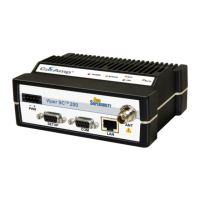#9 Viper_SC_Manual_001-5008-000_Rev12e.docx | Page 38
Figure 24 – Setup (Basic)Serial Ports
― Speed. Select Baud Rate to match connected device. SETUP 300/1200/2400/4800/9600/19200 Baud Rate. Default =
19200. COM 300/1200/2400/4800/9600/19200/38400/57600/115200. Default = 9600.
― Data bits. Number of bits making up the data word. Select 7/8. Default = 8.
― Stop bits. Select 1/2. Default = 1. Marks the end of the serial port data byte.
― Parity. Select Even/Odd/None Default = None. Identify the sum of bits.
― DCD (Data Carrier Detect) Control. Select Never Asserted/Always Asserted/Envelope Mode (the DCD will be asserted
only when data is present at the serial port).
― Packet Forwarding Threshold. Mark Character time allows the user to change time based on the character length to
forward the packet.
― Flow Control. Allows the user to implement RTS/CTS flow control or no flow control. Request to Send/Clear to Send.
Flow control requires a 5 wire connection to the Setup Port or Com Port.
― Connection Control. Select Permanent (3-wire)/Switched (DTR bringup/teardown). Configure to match connected
device settings. Permanent (3-wire), serial port is always enabled. Select Switched (DTR bringup/teardown) to
enable/disable the serial connection. DTR on the serial port can be used to open and close the TCP connection.

